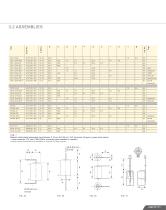
Catalog excerpts

Technical Information TECHNICAL HANDBOOK Primary Lithium Cells
Open the catalog to page 1
Primary Lithium Cells 1.1 Constructions of Lithium Cells 4-5 1.3 Applications for Primary Lithium Cells 7 2. CR PRIMARY LITHIUM BUTTON CELLS_9-18 3. CR HIGH CAPACITY PRIMARY LITHIUM CYLINDRICAL CELLS 19-24 4. CR HIGH POWER PRIMARY LITHIUM CYLINDRICAL CELLS_25-30 4.1 Types - Technical Data 26 Subject to change without further notice. No responsibility for the correctness of this information. For latest technical data please refer to our data sheets which you will find © by VARTA Microbattery GmbH
Open the catalog to page 2
The VARTA Microbattery lithium manganese dioxide cell chemistry was one of the first solid cathode cells commercially developed and is still the most widely used system today. These cells offer an excellent shelf life, good high-rate and low-rate capability, a wide operating temperature range and availability in button and cylindrical cell designs. Potential design-in applications for these products are electronic, telecommunication, metering, instrumentation, office and other portable equipment use. Based on the outstanding cell performance and reliability of these products, they have been...
Open the catalog to page 3
Primary Lithium Cells 1.1 CONSTRUCTIONS OF LITHIUM CELLS VARTA Microbattery offers a complete range of primary lithium manganese dioxide cylindrical and button cells for memory backup and portable applications worldwide. The cylindrical cell configurations offer the high-capacity bobbin construction and high-power spirally wound product. The bobbin construction is targeted at low to moderate power requirements, dedicated for applications requiring up to a 10 years operational life at 20°C. Our spirally wound electrode product offers high-rate discharge capability, with an operational life...
Open the catalog to page 4
Lithium Button Cells FIG. 4 Schematic construction of a Li/MnO2 Button Cell Lid (Negative Terminal) Negative Electrode (Li) Gasket Can (Positive Terminal) Organic Electrolyte + Separator Positive Electrode (MnO2) Sealing Technologies FIG. 5 – CRIMP-SEALING CR High Power Cylindrical Cells Positive Cap PTC Device Gasket Lid Lid Negative Contact Laser Welding CR High Capacity Cylindrical Cells
Open the catalog to page 5
Primary Lithium Cells Main Applications They are therefore ideally suited as power sources for the long term supply of microelectronic circuitry. Both mechanical and electrical properties, together with reliability, ensure that VARTA Microbattery lithium batteries meet the requirements of modern electronics. Long life expectancy and long operational life Low self discharge rate High energy density High cell voltage (3 V) Wide temperature range High operating safety High reliability Resistance to corrosion with stainless steel case No leakage problems with an organic non-corrosive...
Open the catalog to page 6
Main power source Memory backup Cylindrical Cells (Bobbin construction) Memory backup Memory backup Cylindrical Cells (Spirally wound) Main power source Button Cells Main power source 1.3 APPLICATIONS FOR PRIMARY LITHIUM CELLS Std. Telephone Cordless Telephone Cellular Telephone Mobile Radio Utility Meters Heat Distribution Meter Electric Meter Water Meter Office Automation Printer Fax Vending Machine Electronic Typewriter Copy Machine Process Control Equipment Taxi Meter Transponder Intelligent Tagging Electric Parking Meter Data Logger Dive Computer Consumer Products Electronic Games...
Open the catalog to page 7
Primary Lithium Cells To enable battery selection the following is required: ■ discharge current and maximum discharge time - capacity operating temperature range - self discharge - surplus capacity requirement cell size Capacity retention characteristics of VARTA Microbattery Lithium Cells Cylindrical Cells CR…AA and CR…A Typical storage behaviour at room temperature 21°C of CR 1/2 AA FIG. 10 BATTERY SELECTION DIAGRAMM Discharge current/ Operating time
Open the catalog to page 8
2. CR PRIMARY LITHIUM BUTTON CELLS
Open the catalog to page 9
Primary Lithium Cells 2.1 TYPES – TECHNICAL DATA CR 2450 Max. discharge current (pulse) (mA) Max. discharge current (continuous) (mA) TAB. 3 Technical data, CR Primary Lithium Button Cells 1) Nominal capacity is determined to an end voltage of 2.0 V (type 2 CR 1/3 N: 4.0 V) when the battery is allowed to discharge at standard load level at 20°C
Open the catalog to page 10
TAB. 4 Tag material: nickel plated sheet-steel. SLF: tip tinned. Custom made assemblies are available on request for large volume.
Open the catalog to page 11
TAB. 5.1 Tag material: nickel plated sheet-steel. SLF: tip tinned. Custom made assemblies are available on request for large volume. Primary Lithium Cells
Open the catalog to page 12
TAB. 5.2 Tag material: nickel plated sheet-steel. SLF: tip tinned. 1) using Molex 51021-03 connector (Other wire connectors and wire length are available on request.) Custom made assemblies are available on request for large volume. in shrink sleeve with wire and connector
Open the catalog to page 13
Primary Lithium Cells Discharge characteristics Cell capacity vs. discharge current
Open the catalog to page 14
Discharge characteristics Temperature characteristics
Open the catalog to page 15
Primary Lithium Cells Discharge characteristics Operating voltage vs. current drain
Open the catalog to page 16
Discharge characteristics Temperature characteristics Operating voltage vs. current drain
Open the catalog to page 17
Primary Lithium Cells Internal Resistance Ri calculated from Mean discharge Discharge curves at different temperatures Mean discharge
Open the catalog to page 18
3. CR HIGH CAPACITY PRIMARY LITHIUM CYLINDRICAL CELLS
Open the catalog to page 19
Primary Lithium Cells Max. continuous discharge current (mA) Nominal capacity at 20 °C, down to 2.0 V, load (mAh) 3.1 TYPES – TECHNICAL DATA TAB. 6 Technical data, CR High Capacity Primary Lithium Cylindrical Cells
Open the catalog to page 20
wire & connector single pin wire & connector TAB. 7 Material: nickel plated sheet-steel, tag thickness: 0.15 mm till 0.25 mm. SLF: tip tinned, all types in green shrink sleeve. 1) using connector: JST type: PHR2 (Other connector types available on request.) Custom made assemblies are available on request for large volume.
Open the catalog to page 21
Primary Lithium Cells Discharge characteristics Operating voltage vs. current drain, Cell capacity vs. discharge current
Open the catalog to page 22
Primary Lithium Cells Discharge characteristics
Open the catalog to page 24All VARTA Microbattery GmbH catalogs and technical brochures
-
Primary Alkaline Round Cells
2 Pages
-
Coin Power
44 Pages
-
EasyPack
2 Pages
-
CoinPower
66 Pages
-
Lithium Primary Cells
50 Pages
-
NiMH Button
52 Pages
-
63094
1 Pages
-
63074
1 Pages
-
63165
1 Pages
-
63145
1 Pages
-
63125
1 Pages
-
Company Image Brochure
13 Pages
-
Rechargeable Lithium Button
2 Pages
-
Product Overview
4 Pages







































